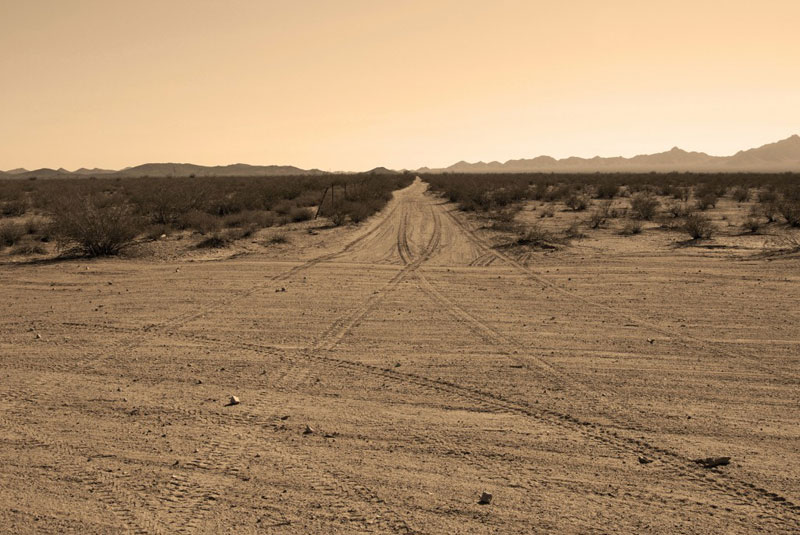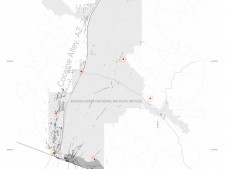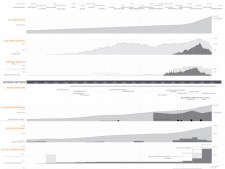
THICK-BORDER: Building the Military-Environmental Complex ©
1. Preamble
The Border Patrol cannot ensure safety along a 2,000 mile border. The land management agencies under the Department of the Interior cannot fulfill their mission to protect the land for the greatest good for the greatest number. Thus, we are at an impasse in terms of national and ecological security.
The border landscape is not a geographical line but rather a continuum of contested landscapes, both thicker and more complex than cartography depicts. Some of these landscapes are American, some Native American, and some Mexican. Some are developed and urban while others are undeveloped and ecologically valuable. Some are monitored by the Border Patrol and others are not. But they are all contested. Inside the military intelligence world, this prolonged conflict is actually considered a war fought at low-level frequency and over long periods of time. For this reason, the border and its conflicts are part of the “Long War”, generally formulated in response to long-term national security threats such as narco-trafficking and global terrorism (see chart for metrics tracking general escalation).
Currently, those landscapes that are on the public/ecologically-valuable end of the continuum are being trampled by both the governmental agency activities and the waves of immigrants crossing the border. In the late 1980s and 1990s, a massive governmental effort to crack down on illegal immigration focused on a few major crossing points near urban areas (i.e., El Paso, TX or San Diego, CA). But rather than stemming immigration, this discrete enforcement simply funneled immigration paths into far more remote and dangerous areas throughout the southwest, such as the Tucson sector in Arizona. Since 1995, the U.S. Government Accountability Office reports that immigrant deaths have doubled.
Along with the more docile migrant labor immigrants, there are massive infusions of drug runners into the remote, public and protected lands in the southwest U.S. One wildlife refuge became such a common drug-running route it was dubbed “Cocaine Alley” (see map/data from US Fish and Wildlife). The rampant destruction and trashing of high quality habitat, disturbance of wildlife, and escalating danger to human life (migrant, visiting public, or officials) renders the border landscape a null and void asset held in public trust.
2. Borders through Macroscope
If one were to view the border landscape through a temporal-physical macroscope, several emergent properties would materialize:
2.1 Border walls are a laughable obstruction in the face of a massive economic gradient that draws immigrants to the U.S. Even if all the walls of the Secure Fence Act were constructed, it would cover a mere 37% of the actual border at varying levels of robustness. Tunnels, mobile ramp bridges, and sheer remote trekking subvert such blunt tactics daily. The running joke is that Nogales, AZ could soon collapse into itself due to all the tunnels that run underneath that border town. Obstructive measures will only continue to push immigrants into remote areas where they endanger themselves and the land. Border walls obstruct wildlife, not people. Roaming species, like jaguars, were just beginning to re-establish populations on American soil when the Secure Fence Act and Patriot Act instructed agencies to ignore environmental concerns in pursuit of a fictitious security wall.
2.2 Militarization has already occurred. The Border Patrol’s numbers have surged to over 11,000 while the National Guard has been deployed multiple times in the region. These numbers do not take into account the many security experts, analysts and contractors in the region testing new devices such as UAVs (unmanned aerial vehicles) and surveillance infrastructures. On the Mexican side, the Mexican Army has been deployed for years now to assume police duties in a quasi-permanent state of martial law. Incursions into the U.S. territory has occurred on multiple occasions. Some border areas, despite being public land, are indefinitely closed to the public.
2.3 The drug organizations and coyotes (human smuggling operators) are fully aware that certain segments of the border are managed by poorly funded, undermanned agencies like the National Park Service and USDA Forest Service. Thus, they target these areas to smuggle drugs and humans across, both endangering the public and trampling on highly sensitive desert ecologies in the region.
2.4 Paradoxically, severely restricting human access through massive military buildup creates a haven for wildlife. Other borders in the world with levels of security significantly higher than ours exhibit what I call the Military-Environmental Complex. Squeezed out of so many areas by human alterations of habitat, plants and animals quickly re-establish in areas of high security such as the Korea’s Demilitarized Zone or the former Iron Curtain path in eastern Europe. This basic condition holds on most large military bases in the U.S. as well, preserving rare habitats through exclusion, while surrounding areas over-develop. Extreme military intervention produces extreme environmental benefits.
3. Proposal: Militarization as Transitional Phase
All public lands along the U.S./Mexican border should be temporarily transferred to the jurisdiction of the Department of Defense (see border image from former military bombing reserve). Border lands would be closed to both immigrants and the public, with the exception of a few select public education visits (to be determined by annual lottery). The ultimate ecological benefits would accumulate over a trial phase of one generation (20 year period). The most highly prized habitat will later be transferred back to the public land agencies once the immigration issue has been solved either through new legislation or evolved economic conditions. The benefits are manifold:
3.1 The far more expansive Defense budget can better manage the security threat and cover the scale than the current overlapping mesh of underfunded agencies.
3.2 The Defense Department needs training areas of significant size and remoteness to truly approximate the conflict zones worldwide. Noise, light, and air pollution severely hamper the training missions carried out continuously at more land-restricted bases across the U.S. More of these bases could then be transferred to state and local entities capable of re-investing the vestigial habitat benefits of the military bases. Park space could multiply across the nation near growing metropolitan areas.
3.3 The law of unintended consequences will work in the public’s favor. By amplifying the security apparatus, ecological habitat and biodiversity are increased while immigrant deaths and risks are decreased. The noise, light, and air pollution that the military wants to avoid also distresses wildlife. By protecting a non-polluted condition near the border with a military reserve, an expansive refugium will be created out of a militarized space.
3.4 Accumulating benefits may attract international support as well as private partnerships. The current stalemate scenario where everyone loses–public land is damaged, wildlife are blocked/trammeled/distressed, public cannot visit the border area, immigrants risk lives in crossing remote areas, budgets are strained by unconventional enforcement range, etc.–will be forced to evolve as an output of the military-environmental complex. The peace dividends equally fall into social and environmental realms, the ultimate win-win scenario.

